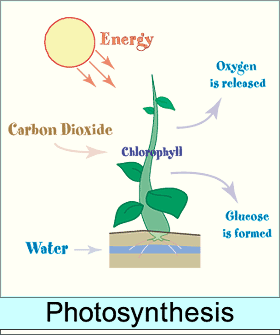What conditions and molecules are needed to carry out photosynthesis?
Sunlight, carbon dioxide, and water.
What form of energy does light energy transform into during photosynthesis?
Stored chemical energy.
Explain why a plant can live and grow without soil.
A plant doesn't need soil to get energy. Dirt is not part of the equation.
Where do the oxygen atoms end up during photosynthesis?
The atmosphere and glucose.
What is the chemical equation for photosynthesis?
6CO2 + 6H2O ⟶ 6O2 + C6H12O6
What are the reactants and products in a chemical equation?
Reactants: Molecules before the change.
Products: Molecules after the change.
Why can only the green parts of plants photosynthesize?
Chlorophyll reflects all green light.
What would happen to CO2 levels if there were no plants?
CO2 levels would continue to increase.
Define energy.
Energy is something that causes a change in something else.
Name three factors that affect photosynthesis.
Water supply, amount of sunlight, and levels of CO2.
Illustrate how photosynthesis transforms light energy into stored chemical energy.

Explain how carbon dioxide and oxygen levels have been affected by the increased number of photosynthetic plants.

Carbon dioxide levels have decreased and oxygen levels have increased.
Give two examples of energy transfer.
A car converts chemical energy to kinetic energy.
A toaster converts electrical energy to thermal energy.
What do the plus signs, arrow, and subscripts represent in a chemical equation?
The plus signs represent combining molecules, the arrow represents a chemical reaction, and subscripts represent the number of atoms in a molecule.
How does a plant obtain sunlight, carbon dioxide, and water?
The plant has pigments to absorb sunlight.
It takes carbon dioxide from the air through stomata in the leaves.
It takes water from the soil through its roots.
What is a possible cause of increased CO2 levels in the atmosphere?
A decrease in photosynthetic plants.